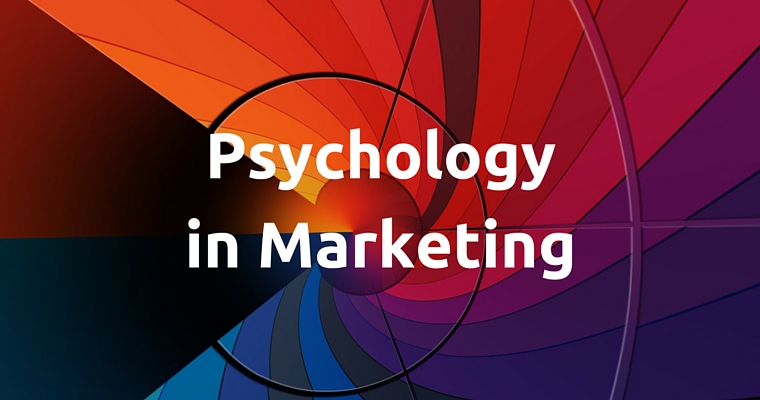According to this definition, the sole purpose of marketing is to develop satisfying relationships with customers that benefit both the organization and its customers.
But that is hard to do unless you truly understand what makes your audience tick, isn’t it?
Enter psychology.
Fact: psychology and marketing have always gone hand in hand.
A majority of marketing campaigns (or at least the most successful ones) are based on a thorough understanding of the principles of human behavior.
If you are looking for some information about what makes us choose one product over another, for instance, I have a real treat for you.
In this post, I’ll show you what influences our decisions and how you can use it to improve the effectiveness of your online marketing activities.
What Influences Our Decision Making?
A major aspect of marketing is persuading people to make a decision (or to help them change their minds). And so, a lot of psychological research that marketers and advertisers are interested in revolves around understanding the human decision-making process.
It turns out that, for the most part, making a decision is actually too much effort.
Here are some studies and findings to prove it.
When Unable to Decide, We Simply Imitate Others
I’m sure you’ve noticed that whenever you’re unsure about what choice to make, you look to the behavior of others for cues on what the proper course of action would be. Consider the following examples:
- You choose a full restaurant over an empty one, even if it means waiting for an hour to be seated
- When selecting a product, you choose the one with more reviews
- You choose who to follow on social media based on their number of followers.
This is a well-known phenomenon you might know as social proof, although I prefer to use Robert Cialdini’s term – consensus, the sixth principle of persuasion.
Here’s a great video that explains how it works and how to use it to persuade others to take action (start watching around the 9:00 mark).
This behavior also affects our product selection.
In two studies conducted in 1998, David Wooten, a researcher from the University of Florida’s Department of Marketing, determined that the opinions of others can influence consumers’ product evaluation process.
You can read more about his research on ResearchGate (login required).
Other research resulted in similar findings:
Econsultancy cites various research confirming that 61 percent of consumers read reviews before making a purchase decision.
And last year, TripAdvisor’s study revealed that 77 percent of travelers don’t book a hotel without reading what others have to say about it first.
It goes without saying that featuring social proof like reviews, star ratings, or testimonials about your business is bound to elicit a positive reaction from visitors and inspire them to take action.
But social proof isn’t the only time we take a shortcut when forced to make a decision.
We’re Always Looking for the Easiest Solution
It turns out that we also prefer to accept the default option, rather than to stop, think and decide for ourselves…even if it’s not what we would normally choose.
In his fantastic TEDtalk, behavioral economist Dan Ariely cited various studies show when we are pressed to make a decision and are unable to make a call, we shut down and select the default option.
For a marketer, this means sometimes the easiest way to get someone to agree with you is to present them with a default choice.
A good example of targeting this behavior is including a newsletter signup box at the end of a checkout form. “Stressed” by the whole process, many customers will overlook this option, leaving it set to default (which often might mean unknowingly agreeing to sign up for the mailing list).
Too Many Choices Shut Us Down
Similarly, when presented with too many options to choose from, we shut down and often end up choosing a random option just to get out of the situation.
Barry Schwartz describes this phenomenon in his book The Paradox of Choice, and here’s the talk where he explains the core concept of the theory:
But sometimes offering a lot of choices is not the best option in marketing. A variety of choices–for example, a variety of subscription plans—can paralyze the user. It’s better to create a situation where you can choose for them!

During his TEDtalk, Dan Ariely also showed a great example of a pricing plan page by The Economist. The possibility of getting both a print and a web subscription for the same price as only a print subscription attracted 84 percent of all users. The print-subscription-only offer got less. It seems like it was useless to include it in the first place, but as it turns out, with the option of a print subscription alone, the print and web subscription didn’t seem attractive at all!
Bottom line—offering a variety of choices is not always a good option. A way to get better results is to make a choice for the user and give them an offer they can’t reject.
Irresistible Offers Make Us Change Our Mind
Continuing with the topic of irresistible offers, it turns out that when presented with one, we can quickly change our mind. And that’s even true in situations where we previously held firm beliefs.
A 2013 study from the Global Journal of Management and Business Research concluded that even though we often develop a very strong brand loyalty, we are willing to make other choices when presented with an irresistible offer.
This means an incredibly attractive offer might spur people into taking action on your site.
This could mean offering a discount or a sale but also:
- A lead magnet visitor would have to register on the site for. Information collected this way would help you learn more about people interested in your offer.
- It’s an incentive to convince visitors to answer a couple of questions on a survey, etc.
But what makes an offer good enough to get them to act?
For one, it should be a clear promise. Your visitors shouldn’t have to think about what value they’re getting.
Secondly, it should promise a solution for one of the key pain points of your audience.
Lastly, the value should outweigh the cost.
We fall for authority
When making decisions or even deciding on the next-best action, we tend to follow what people we consider authorities say or do.
But it’s important to establish someone’s authority on the basis of cues we associate with it.
In his book Influence, Robert Cialdini lists some of the most common ones:
- Impressive job titles
- Expensive clothes
- Luxury cars or other possessions
Neil Patel, in his article “How Spending $162,301.42 on Clothes Made Me $692,500” explains that “People believe what they see.” If people think you look successful, in their eyes you are successful.” And he proves that investing in a successful look will pay off.
When it comes to online marketing, these cues would include a large social media following, previous publications on high-authority sites and so on. From these cues, we often take action based on the authority’s instructions or recommendations. And many experiments have proven we are willing to go beyond what we’re normally comfortable with.
These cues force us to respect and obey people we deem authority figures more than we would do in other circumstances. Therefore, to improve the effectiveness of your marketing, you should focus on developing authority cues your audience will recognize.
Curiosity Makes Us Listen
One of the greatest marketing challenges today is to actually get a visitor’s attention and get them to listen. One way to achieve this is by targeting what’s known as the curiosity gap.
This term was first introduced by George Loewenstein, and it refers to our underlying need to fill in any blanks in our knowledge.
And the psychological mechanism behind this is actually quite simple: when we realize we don’t know something, we immediately feel compelled to find that missing piece of information.
In marketing, this behavior is most useful when writing headlines and social media updates.
Consider Upworthy, for example — the site features mainly curiosity-driven headlines that on average receive 152 percent more Facebook likes than headlines from other sites.
If you want to find some good examples of writing that peaks curiosity, check out Brian Dean’s blog and newsletters. I like his Barney Stinson style: Wait for it, wait for it, wait for it…and then boom! He comes out with the solution. A great thing about it is that sometimes his solution can be trivial and simple.
Of course, you don’t have to change people’s’ lives with every newsletter – and you can’t. Say what you need to say; if your content is curiosity driven, every word will be heard.
Words Affect Us
Lastly, the words you use in marketing campaigns can affect your audience’s behavior too.
Words like you, free, or because persuade users to take action:
- You creates a personal connection
- Free suggests an incentive and keeps visitors interested
- Because gives a reason, and that’s often what visitors need to take action (as confirmed by research)
Last year, we conducted research to find out the most popular adjectives used by AdWords advertisers. It turns out words like free, cheap, or new topped the list, with the first one greatly outnumbering the others.

What does this information give us in terms of marketing?
Pay attention to calls to action and think twice about ad copy text – all small messages and messages that encourage a user to act must be checked twice. And of course, don’t forget about A/B testing. Even for experienced marketers it’s hard to predict the results that each copy will bring.
Check out this article by Steven Macdonald and amazing results of his CTA A/B testing – “Twice as many people were now visiting the form when we added a sense of urgency to the CTA copy and used “start” instead of “get”. Think about it! Just one word made a huge difference.
Conclusion
Influencer marketing, content marketing, A/B testing for the best CTAs—you are doing these already. But next time you’re developing a sign-up form or thinking about a new offer, dig a little deeper. Psychology can provide the insight you need to better understand what makes your audience click, signup, or buy.
Image Credits
Featured Image: Image by Olga Andrienko
The Economist subscription image: danariely.com, used with written permission
Charts: Screenshot from SEMrush’s research, originally published in Entrepreneur.com


